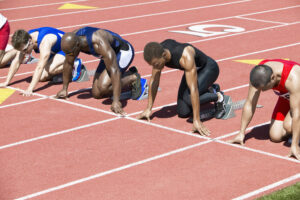COVID-19 has taught us that profitability and sustainability are not conflicting goals; they are inter-twined to achieve an equitable economic growth.
Arun Pandey, Chairman and MD, Rhiti Group explains that in our endeavour to become ‘Atma Nirbhar’, it is important that we grow economically and of many other sectors contributing to economic and social growth is the sports sector. Its significance is valued and well recognised by the Government especially in empowering women and youth. Be it health, education or social inclusion objectives, sports has been imprinting an everlasting mark in all the spheres of life from time immemorial.
Covid-19 is Impacting the Sports Industry
However, since the onset of COVID-19 crisis, measures that have been taken by the Government to curtail the spread of the disease, have also disrupted many regular aspects of life, including physical activity and sports. To safeguard the health of athletes and others involved, most major sporting events at international, national and regional levels had to be shelved. So much so, that for the very first time in the history of modern games, the Olympic and Paralympic Games have been postponed to a later date in the year 2021! Many, who are a part of the sports industry, are walking a tight rope in trying to hold onto their jobs. Along with the economic repercussions the COVID crisis has also impacted the generation of social cohesion through sporting events and activities. According to a Bizzabo marketing report, last year more than 40 percent of marketers named live events as the most important marketing channel. With seasons postponed or canceled, the suspension and standstill of sports isn’t only a disappointment to fans; it’s a disruption to business. For brands that rely on these events for advertising revenue, it’s devastating. According to Statista’s analysis of the sports industry, a loss of approximately $2.2 billion of national TV revenue is expected as a result of Covid-19, in addition to around $3.5 billion in fan spending on professional sports
It is about time that India’s Sports Policy underwent a drastic change by incorporating new partnerships and strategies in order to adapt to the new normal and thrive.
Marketing During and after the Pandemic: Digital is the way ahead
Even before the pandemic, the sports market and broadcasting landscape was shifting. The sports community has adapted rapidly by creating online content tailored to different people; from free tutorials on social media to paid virtual practice sessions, to players risking their health to start playing again, relentless efforts to realign sports as an integral part of lives is on. Therefore, it’s imperative that businesses make the adoption and improvement of digital capabilities a priority. Athletes can use their social presences and platforms to share training techniques and workout videos. This presents sponsorship and partnership opportunities, both, for brands and sportspersons. Furthermore, brands are also creating digital content specific to their industry to reach out to clients.
Also, brands need to adjust their media investments based on the moods and expectations of consumers. Building brand credibility should be prioritized over sales promotion. For example, at a time when demands of essential goods are shooting over the top and there are low inventories and delays in deliveries, there is no point in running online campaigns and discounts to acquire new consumers. Instead of making efforts to acquire new customers, e-commerce marketers should focus on nurturing existing customers with the highest lifetime value
Managing sponsorship and finances: More strategic partnerships and advertising
Emphasis on allocating advertising budgets to create more tailored content and promotions to establish a more targeted expenditure is vital for sports brands now. Affiliate marketing can help digital marketers increase brand awareness and engagement rates in areas they may not have previously pursued. This in turn will benefit the brands as well. Exploring more creative promotion and advertising opportunities is helping brands stay relevant while curbing needless expenditures. For example, digital advertising is saving the cost of venue spends which is required when indulging in a physical advertising session . Eventually, it can also help attract fans who are looking to fill the absence of professional and live sporting events with virtual, competitive alternatives.
Extending support and communicating as per the context: using carefully crafted messages
The current crisis is a great moment for brands to put out responsible communication that supports people simultaneously ensuring that their communication is brand safe and relevant. However, brands have to be extra cautious about putting out their communication in the right context or else they might face the flare. Some sports brands like SEVEN have identified the unique role sports plays in the lives of sports enthusiasts and are considering ways of helping them during this crisis period. An added feature in their service that helps people stay at home and feel safer, while they remain connected to sports, albeit virtually will enable brands to survive and thrive in the future.
Let’s set the ball rolling: moving forward towards normalcy
Rohan Bopanna found playing tennis in COVID times a completely different experience. Yet, he took the risk to fly to the USA to play because, somewhere the ball had to be set rolling! From sportsmen who are travelling and putting up with the restrictions of living in a bio-secure bubble to sports brands attempting to stay connected with clients and sports enthusiasts, even while being distant, each element constituting the sports ecosystem is mitigating the COVID-19 crisis in trying to move ahead towards the new normal.

